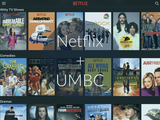UMBC Now Has a 100 Gb Connection & Faster Netflix Loading
Enjoy more streaming on a faster network connection
DoIT would like to announce that UMBC now features a 100 gigabit connection speeds available on campus. In addition, there is now a Netflix node installed in the Data Center on the ground floor of the Engineering Building.
The Netflix node is a server that holds the video content that is streamed to your device. When streaming a show or movie from Netflix, your data is typically streamed from nodes deployed across the country and world. Traditionally, Netflix tries to have your stream come from a node that is closest to you, delivering the best possible streaming experience.
This is all possible thanks to the Netflix Open Connect program and Norwin Malmberg, Chief of Network Technology at Maryland Research and Education Network (MDREN). The Netflix Open Connect program partners with Internet Service Providers (ISPs) to provide Netflix customers the highest quality viewing experience possible by localizing substantial amounts of traffic.
MDREN acts as an ISP and provides advanced network services to multiple University System of Maryland (USM) schools, private colleges, and community colleges throughout the state. Malmberg contacted Netflix and was able to get membership into the Open Connect program, thanks to MDREN consuming sufficient Netflix bandwidth throughout all the varied partner campuses and organizations to qualify for a node.
UMBC volunteered to partner with MDREN and host the node on our campus to provide the best possible service to not only our student, but students throughout the state.
"High speed connections and low network delay..."
Mike Petry, General Associate for DoIT, helped install the node on campus on April 25th, 2016. Petry said, “The benefits to UMBC and the other USM campuses is having a node with high speed connections and low network delay that is able to serve up content to campus connected users.”
A network map that shows how UMBC is connected to the MDREN network. The streaming is outbound from the node toward the customer watching a stream. The node is physically on campus, but should be viewed as being on the MDREN network. You can view the bits per second here and hover over each path.
“Netflix knows what content is on which servers and will direct a server that does have it to start streaming it to you.”
Users won't have to do anything on their part and instead just stream Netflix on their device as they normally would, as the server selection for delivering your stream is done behind the scenes by Netflix software. “For instance, you may requests a movie that isn't on the server on campus.” Petry said, “Netflix knows what content is on which servers and will direct a server that does have it to start streaming it to you. The win for them is to have the most popular content as close as possible to avoid long network paths.”
Happy streaming.
Posted: June 8, 2016, 7:55 AM
